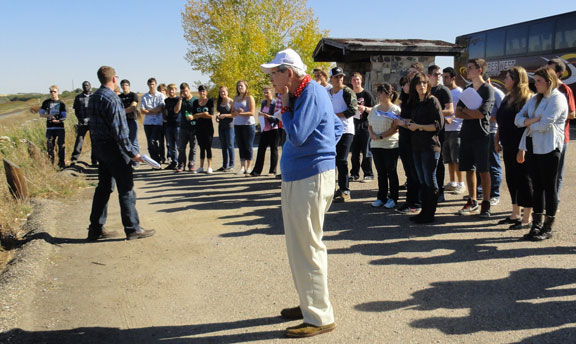Mollard donation takes students into geological landscapes of Saskatchewan
A recent donation from U of S alumnus Jack Mollard will give engineering students opportunities to learn more about interpreting the geological landscapes of Saskatchewan.
By Kris Foster The Dr. Jack Mollard Sensing the Earth Tour, established this past September with a $100,000 gift, will give about 130 second-year civil, geological and environmental engineering students a chance to explore about a half dozen geologically significant locations between Saskatoon and North Battleford, said Jim Kells, head of the Department of Civil and Geological Engineering.
The Dr. Jack Mollard Sensing the Earth Tour, established this past September with a $100,000 gift, will give about 130 second-year civil, geological and environmental engineering students a chance to explore about a half dozen geologically significant locations between Saskatoon and North Battleford, said Jim Kells, head of the Department of Civil and Geological Engineering.
"The number one goal is to get the students out of the building and into the field," explained Kells, who worked with his colleague Grant Ferguson and the Mollard family to figure out how the gift could be best used in the college. "Students get to see features of the physical landscape that are important to our profession, like river valleys, glacial features and unstable slopes, and have them explained to them."
Human interaction with the natural environment like road construction or pipeline development is critical to civil, geological and environmental engineers, Kells continued, comparing the field trip to medical students getting time in the operating room.
"The visual experience of the site, what we can infer by seeing the environment, how one can understand the engineering significance expressed in the features of the physical terrain, is an important tool," Kells said. "This one-day field trip will help students interpret the landscape. We're an earth-based discipline and we need to be able to determine and predict how the land will behave if we build (on it)."
Sensing how the Earth might behave, said Kells, is how Mollard made a name for himself.
"Remote sensing of the landscape through aerial photography is what Dr. Mollard is well-known for. He brought this technology to Saskatchewan and Canada and is a pioneer in the area. Through his work, he has had such a profound effect on remotely sensing the terrain for engineering purposes."
Mollard graduated from the U of S in 1945 and completed his master's and PhD at Purdue University and Cornell University respectively, before returning to Saskatchewan where he set up J.D. Mollard and Associates in 1956.
Among Mollard's more than 5,000 consulting projects is work he did on the Gardiner Dam project in the late 1940s and early 1950s.
More recently, but much further from home, Mollard is doing work on terrain analysis of Mars. "He's looking at imagery of Martian landscapes, in particular water features," Kells explained.
"He'll be 90 this January, and still goes to the office every day. He is so passionate about the profession and loves what he does so much that he admits that he may not have worked a day in his life," Kells said with a laugh.
Mollard's passion for the work is obvious to those who meet him too. "As part of the inaugural field trip, Dr. Mollard not only joined the students on the tour but also made a presentation to the participating students the day before. The students were enthralled listening to his story and Dr. Mollard enjoyed the opportunity to share his knowledge and passion."

